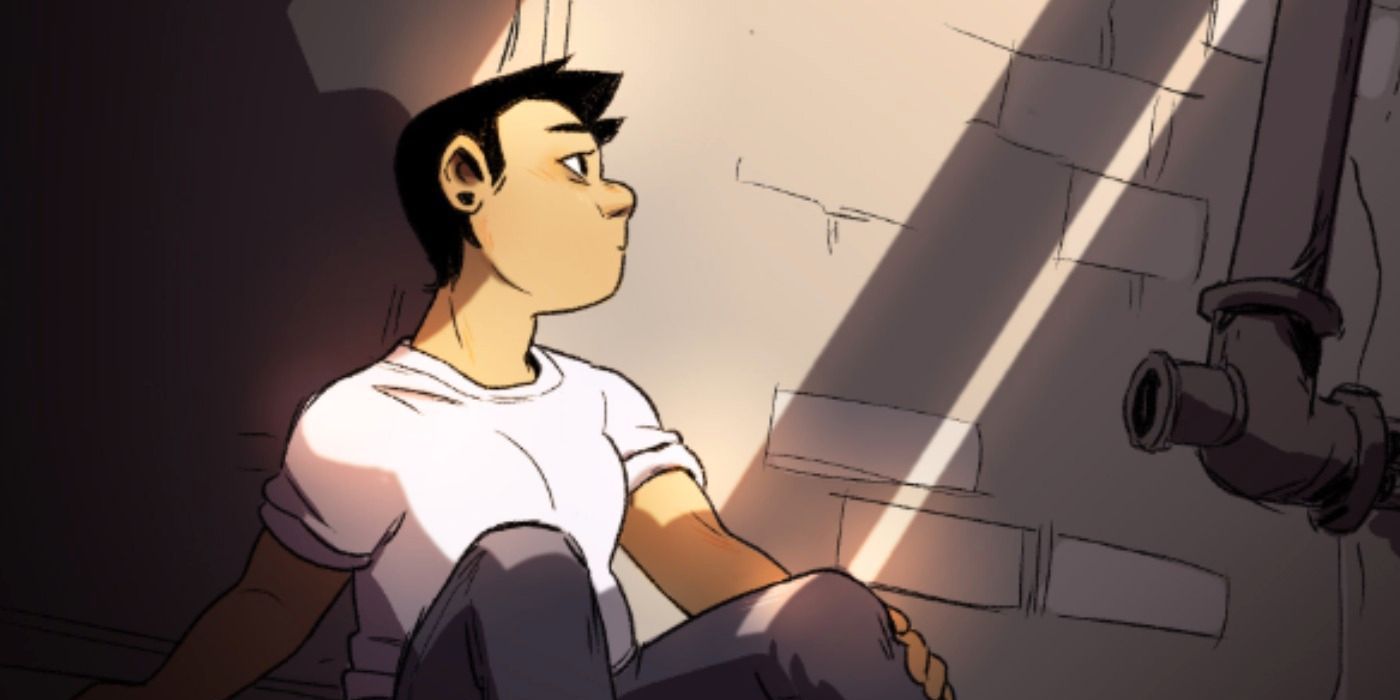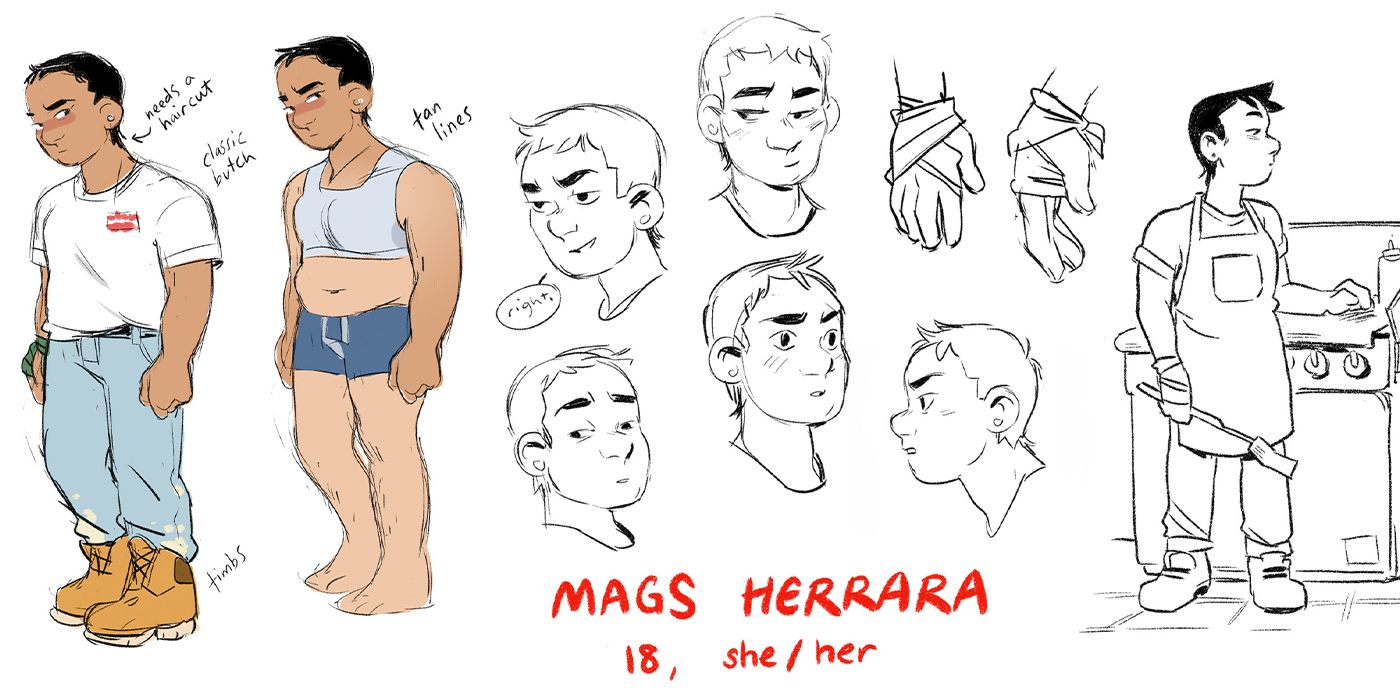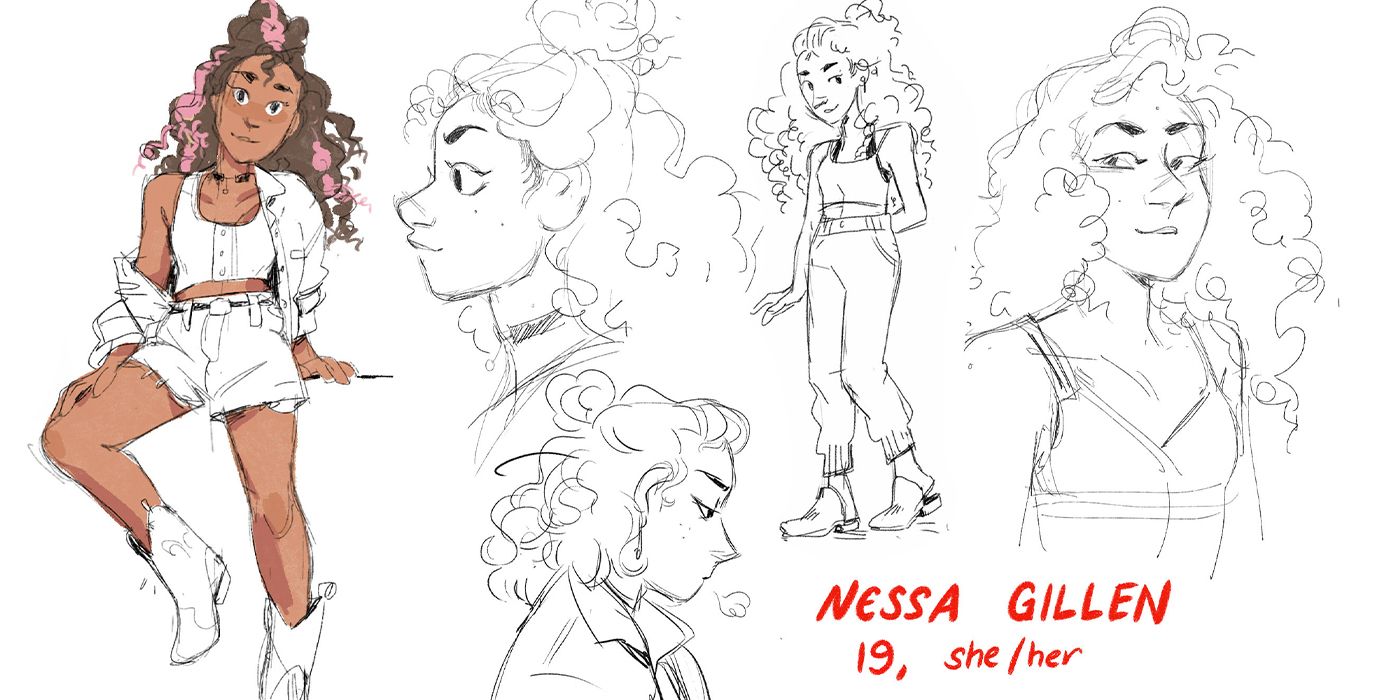Molly Ostertag is returning to the world of digital comics with a brand new Substack project, Darkest Night. The graphic novel tells the story of Mags, who was born with a secret that she keeps locked in her basement. As she deals with the troubles in trials in her own life, a friend from 10 years ago returns to her life, leading Mags on an all-new adventure.
Molly Ostertag is a popular cartoonist whose work on Strong Female Protagonist, Tales of the Night Watchman, the Witch Boy trilogy, and writing for The Owl House on the Disney Channel have all been critically acclaimed. Ostertag was one of the many creatives who made the recent jump to the Substack platform. We talked with Ostertag about making the jump to Substack, Darkest Night, and what readers can expect from the new series.
How did this project come to be?
Molly Ostertag: I've made a good handful of graphic novels at this point, all for younger readers. And I was having trouble figuring out what I wanted to do next, because I felt like I'd hit a bunch of the goals that I had. I finished Girl From The Sea, which is a sweet YA supernatural romance. And I was like, "I can make something else like this," because I really loved making it. But I didn't want it to push myself a little, so I started coming up with an idea for a story that I had in the back of my head for a while.
I started seriously sitting and working on it and, with really good timing, Substack offered me a grant to make a newsletter. I thought that would be a really good way to motivate myself and just put out the story exactly the way I wanted to, rather than taking it to publishers who I knew would probably - based on my history - want to make it a little bit younger than it is.
There was something kind of fun about the chance to go back to making a webcomic, which is really how I started in comics.
This comic lends itself perfectly to the digital format. Is that something that you wanted to pursue with this project?
Molly Ostertag: Yeah, it's all drawn in a long scroll, which I really love. It really is how I think about comics. I feel like there's so many chances for cool pacing while you're scrolling through it, rather than turning the page. They're different formats, but I think after drawing a ton of graphic novels for traditional print, getting to do something a little bit more experimental has just felt so fun and so interesting.
There are cool things I can do, like I've been sharing a song every update. Each update is a short scene, and I share a song that will set the tone for it, so that people can listen to that. I have a couple of ideas for bringing in light animation into certain things; stuff that you only can really only do in a webcomic. That's been super fun.
What was it like to be part of this wave of creators taking on a newer platform for comics with Substack?
Molly Ostertag: It's definitely been interesting trying to figure out what the actual, literal format of the post is, and how I can optimize that for art. Because it's different than something like Tumblr or Twitter. But I really enjoy the chance to have a bit of a more intimate and closed room of a following, rather than having to be on the World Wide Web of Twitter. That can sometimes get a little overwhelming, how you're just talking to everyone in the world at once. So, I liked that.
I appreciated that it was a very nice opportunity for Substack to reach out and basically be like, "We're going to give you a grant to make whatever you want." That felt like a really kind and very exciting opportunity. I've been having fun making a bunch of stuff I've been wanting to do for a while, but hadn't had the chance to.
What was behind the decision to donate funds from subscribers to trans charities?
Molly Ostertag: Thank you. As I said, I'm getting this grant. I knew that I wanted to put something behind a paywall, but I didn't really want to collect that money because I already was getting paid to make this work, basically, and I didn't want to collect it from readers. So, I just chose to send it and match it to trans charities.
Something that I've been talking a lot about internally with Substack people is that they have some pretty heinous transphobes on their site, so I felt like donating to trans charities was one way to adjust that. I'm also having conversations with the people that I'm attached with there to really push them to impose more regulations, or ban those people - because I really don't think they should be there.
But I always want to - if I'm ever collecting money from readers - send it to a charity. I don't want to turn that into payment for myself.
Do you think they've made a concerted effort to listen to some of the more diverse voices they brought in? Obviously, as you mentioned, they do have some unsavory people on their platform.
Molly Ostertag: Rampant bigots is the term.
Honestly, I feel like the wave of people that they're reaching out to is [great]. Any new site needs to make a concerted effort not to become a breeding ground for hate speech, because I think that they're just very quick to jump anywhere. I'm glad that they're reaching out the people and funding a bunch of queer creators to make work, and I hope that there's more of that to come.
I got a chance to read a small preview of the book, and I am very intrigued to see where it goes next. I was wondering if you could talk about the characters, starting with the protagonist Mags?
Molly Ostertag: Sure, yeah. Mags is our main character, and she is a teenage girl in her last year of high school. She's pretty checked out of school, and pretty checked out of her life in general. She shows up to be what people in her life need from her, whether it's her aging grandmother who needs care, or whether it's the hot girl at school who wants to make out with a butch lesbian and have experience. Mags is whatever people need from her.
That's where she really starts the story at, and it's a mindset that I relate to a lot and have lived in a lot. I really wanted to explore what that feels like and what that looks like, and what it looks like to come out of that and have a personal growth arc.
Mags is really fun to draw. She's very butch, which is just a character I hadn't seen a lot in media - including in my own work. I myself am pretty butch, so I really wanted to draw her as a protagonist and as this emotional character and subject of desire and romance. I wanted to really put her in that role.
Then our other main character is Nessa. She's Mag's old friend from childhood, and she left for a serious reason 10 years ago. She is back in town for Christmas and is catching up with Mags for the first time. She'd led this very different life, where she's very actualized and going to school in LA. She's had all these experiences, and she's had a very different life. So, she's shining a light into the parts of Mags' life that Mags has never wanted to look at.
Honestly, I just love these two girls, so a lot of the story is long conversations between them as the mystery slowly unfolds.
I did see a flashback between Mags and Nessa, where it's basically her talking about her identity and how she feels more like a girl and not a boy. How important is it to see this representation in comics done well?
Molly Ostertag: It's funny, because I haven't thought about the representation in my work for a while. I really just think about my friend group, who I want to see, and who I know and like. I think about the kinds of people that are really integral to my queer community.
With Nessa, it just felt like a very familiar thing to have a child friend who you were drawn to for a certain reason, and neither of us could understand. And then later, when you meet up as young adults, you realize you're both queer and you see them in this new way. "Oh, you transitioned," or "Oh, you're presenting in a way that that is really different and really true to yourself." There's something very cool about that, and it's an experience I've had a lot lately of just catching up with older friends and getting to see them being their true selves.
I think any queer person really knows that feeling of meeting up with a kid that you were best friends with in fifth grade, and suddenly you're like, "Oh, my God. What are the chances that we were both lesbians?" We're drawn to each other on that level, so that's kind of their dynamic.
Without spoiling anything, Mags seems to be hiding a pretty big secret. What can you say about that?
Molly Ostertag: It's a central mystery of the book. I'm not setting up a mystery novel with a big twist or anything. It's just a part of her that his kept down in the basement, and it's representative of a lot of the things that she is hiding and burdens that she's carrying. That's something that we'll slowly start to see more of as the story goes on.
How important was it to have a sensitivity reader and do consultations on a project like this?
Molly Ostertag: Yeah, it felt really good. I have a spotty record; I've been doing a lot more recent projects. I think I really realized the importance of bringing in other voices and bringing in people at the beginning of a project, rather than just sending someone a finished graphic novel and getting them to check it over. With this, I worked with my friend Mey Rude, who is a trans Latina lesbian, and also my friend Phoenix Mendoza, who is a Latina lesbian that grew up in Southern California where the story is set.
They both gave me some really good insight, and it was very cool to work with these people who I respect a lot and really get in-depth about the story. I got to be like, "Here's the theme I'm exploring. Does this align and does this ring true for you? Can you give me suggestions? Can you give me advice on how to tell this story? Can you tell me what's working and what feels off?" You're shining a light on all your blind spots, so there's something cool about getting to sit down with people and be like, "Okay, please educate me." Obviously, I'm paying as well, and we're doing it in service of this bigger creative thing like that.
There's something that felt very cool about it, and I'm excited about what both of them brought to the story
How is the story inspired by Joshua Tree? What's the significance of that to the story?
Molly Ostertag: Joshua Tree it a National Park in California. I go there pretty frequently, as it's pretty close to Los Angeles. It's just beautiful; very bleak, but also full of life when you know where to look for it and just so incredibly gorgeous. I was there on a little writing retreat with my partner, and we were just in the middle of the desert in a little Airbnb, coming up with ideas.
I wasn't sure what I wanted my next project to be, but then this story - or a version of the story - came to me fully. I just started writing something that was a little bit like weird prose or like a poem. I started exploring the emotion of the story, and then as I sat with it, I realized that it really could be a full graphic novel. That just was an exciting feeling.
As for the setting, I just wanted to set it somewhere specific and somewhere that I'm familiar with. I've been in California for the last six years, and its landscape is so beautiful and also so drought-ridden. In a story that is about keeping things secret and not being true to yourself, the desert just felt like a really appropriate setting. I haven't quite seen anything else set in that kind of landscape before, so it just felt very natural.
How has your past work shaped this current direction on Darkest Night?
Molly Ostertag: With this, I very much wanted to do something a little older. Something that I really like about doing a webcomic - and doing it as a newsletter, where no one is receiving this comic if they don't want to get it - is that I appreciate that I can do content warnings and sensitivity warnings up front, if I'm exploring something that feels a little more stormy. That just made me happy to be able to do that for my readers.
Girl From The Sea was such a joy to me, It was a really sweet and really cathartic love story. But I also wished I'd drawn these girls a little differently. I wish I had drawn them a little bit more true to my experience of being gay, which was also about this butch presentation and appearing gay as well - very much showcasing that in the way that you dress and your haircut and everything.
I wanted to explore that with Mags, and have her be this very recognizably lesbian character in a way that the girls from Girl From The Sea were not necessarily. Obviously, there's room for all those stories. I think I just finished that book and was like, "My heart really needs to draw someone who looks more like Mags as the protagonist."
Every book I do lets me explore one side of something, and then the next book is getting to explore what I didn't get to do in that first one.
What do you hope readers get from this book? Because I think it's gonna resonate with a lot of people.
Molly Ostertag: I hope people enjoy following this story. Honestly, it's a similar theme to a lot of my work, which is just the ways in which your life opens up when you let other people come into your life and when you are kinder to yourself. I think all of my work is about that in one way or another.
This one is definitely focused on the feeling of having very closed off life and not letting people in, what motivates that, and how to come out of that. I hope that speaks to other people who are familiar with that feeling. It's definitely one that I have lived with frequently, and I hope I'm making something that reaches out to other people.
Readers can subscribe to Molly Ostertag's new series Darkest Night on her Substack page now. The latest chapter can be found here.



